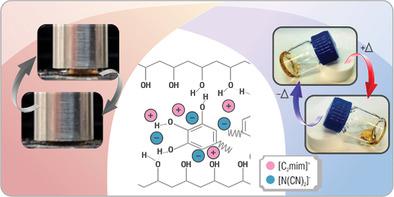当前位置:
X-MOL 学术
›
Macromol. Biosci.
›
论文详情
Our official English website, www.x-mol.net, welcomes your
feedback! (Note: you will need to create a separate account there.)
Elastic and Thermoreversible Iongels by Supramolecular PVA/Phenol Interactions.
Macromolecular Bioscience ( IF 4.4 ) Pub Date : 2020-06-28 , DOI: 10.1002/mabi.202000119 Gisela C Luque 1 , Matías L Picchio 2 , Ana P S Martins 3 , Antonio Dominguez-Alfaro 3 , Liliana C Tomé 3 , David Mecerreyes 3, 4 , Roque J Minari 1, 5
Macromolecular Bioscience ( IF 4.4 ) Pub Date : 2020-06-28 , DOI: 10.1002/mabi.202000119 Gisela C Luque 1 , Matías L Picchio 2 , Ana P S Martins 3 , Antonio Dominguez-Alfaro 3 , Liliana C Tomé 3 , David Mecerreyes 3, 4 , Roque J Minari 1, 5
Affiliation

|
Iongels have attracted much attention over the years as ion‐conducting soft materials for applications in several technologies including stimuli‐responsive drug release and flexible (bio)electronics. Nowadays, iongels with additional functionalities such as electronic conductivity, self‐healing, thermo‐responsiveness, or biocompatibility are actively being searched for high demanding applications. In this work, a simple and rapid synthetic pathway to prepare elastic and thermoreversible iongels is presented. These iongels are prepared by supramolecular crosslinking between polyphenols biomolecules with a hydroxyl‐rich biocompatible polymer such as poly(vinyl alcohol) (PVA) in the presence of ionic liquids. Using this strategy, a variety of iongels are obtained by combining different plant‐derived polyphenol compounds (PhC) such as gallic acid, pyrogallol, and tannic acid with imidazolium‐based ionic liquids, namely 1‐ethyl‐3‐methylimidazolium dicyanamide and 1‐ethyl‐3‐methylimidazolium bromide. A suite of characterization tools is used to study the structural, morphological, mechanical, rheological, and thermal properties of the supramolecular iongels. These iongels can withstand large deformations (40% under compression) with full recovery, revealing reversible transitions from solid to liquid state between 87 and 125 °C. Finally, the polyphenol‐based thermoreversible iongels show appropriated properties for their potential application as printable electrolytes for bioelectronics.
中文翻译:

通过超分子 PVA/苯酚相互作用的弹性和热可逆离子凝胶。
多年来,离子凝胶作为离子导电软材料在刺激响应药物释放和柔性(生物)电子学等多种技术中的应用引起了广泛关注。如今,人们正在积极寻找具有附加功能(如电子导电性、自愈性、热响应性或生物相容性)的离子凝胶以用于高要求的应用。在这项工作中,提出了一种简单快速的合成途径来制备弹性和热可逆离子凝胶。这些离子凝胶是通过多酚生物分子与富含羟基的生物相容性聚合物(如聚乙烯醇)(PVA)在离子液体存在下进行超分子交联制备的。使用这种策略,通过结合不同的植物来源的多酚化合物(PhC)如没食子酸、连苯三酚和单宁酸与基于咪唑鎓的离子液体,即 1-乙基-3-甲基咪唑鎓二氰胺和 1-乙基-3-甲基咪唑鎓溴化物。一套表征工具用于研究超分子离子凝胶的结构、形态、机械、流变和热特性。这些离子凝胶可以承受大变形(压缩下 40%)并完全恢复,揭示了在 87 到 125°C 之间从固态到液态的可逆转变。最后,基于多酚的热可逆离子凝胶显示出适合其作为生物电子学可印刷电解质的潜在应用的特性。一套表征工具用于研究超分子离子凝胶的结构、形态、机械、流变和热特性。这些离子凝胶可以承受大变形(压缩下 40%)并完全恢复,揭示了在 87 到 125°C 之间从固态到液态的可逆转变。最后,基于多酚的热可逆离子凝胶显示出适合其作为生物电子学可印刷电解质的潜在应用的特性。一套表征工具用于研究超分子离子凝胶的结构、形态、机械、流变和热特性。这些离子凝胶可以承受大变形(压缩下 40%)并完全恢复,揭示了在 87 到 125°C 之间从固态到液态的可逆转变。最后,基于多酚的热可逆离子凝胶显示出适合其作为生物电子学可印刷电解质的潜在应用的特性。
更新日期:2020-06-28
中文翻译:

通过超分子 PVA/苯酚相互作用的弹性和热可逆离子凝胶。
多年来,离子凝胶作为离子导电软材料在刺激响应药物释放和柔性(生物)电子学等多种技术中的应用引起了广泛关注。如今,人们正在积极寻找具有附加功能(如电子导电性、自愈性、热响应性或生物相容性)的离子凝胶以用于高要求的应用。在这项工作中,提出了一种简单快速的合成途径来制备弹性和热可逆离子凝胶。这些离子凝胶是通过多酚生物分子与富含羟基的生物相容性聚合物(如聚乙烯醇)(PVA)在离子液体存在下进行超分子交联制备的。使用这种策略,通过结合不同的植物来源的多酚化合物(PhC)如没食子酸、连苯三酚和单宁酸与基于咪唑鎓的离子液体,即 1-乙基-3-甲基咪唑鎓二氰胺和 1-乙基-3-甲基咪唑鎓溴化物。一套表征工具用于研究超分子离子凝胶的结构、形态、机械、流变和热特性。这些离子凝胶可以承受大变形(压缩下 40%)并完全恢复,揭示了在 87 到 125°C 之间从固态到液态的可逆转变。最后,基于多酚的热可逆离子凝胶显示出适合其作为生物电子学可印刷电解质的潜在应用的特性。一套表征工具用于研究超分子离子凝胶的结构、形态、机械、流变和热特性。这些离子凝胶可以承受大变形(压缩下 40%)并完全恢复,揭示了在 87 到 125°C 之间从固态到液态的可逆转变。最后,基于多酚的热可逆离子凝胶显示出适合其作为生物电子学可印刷电解质的潜在应用的特性。一套表征工具用于研究超分子离子凝胶的结构、形态、机械、流变和热特性。这些离子凝胶可以承受大变形(压缩下 40%)并完全恢复,揭示了在 87 到 125°C 之间从固态到液态的可逆转变。最后,基于多酚的热可逆离子凝胶显示出适合其作为生物电子学可印刷电解质的潜在应用的特性。











































 京公网安备 11010802027423号
京公网安备 11010802027423号